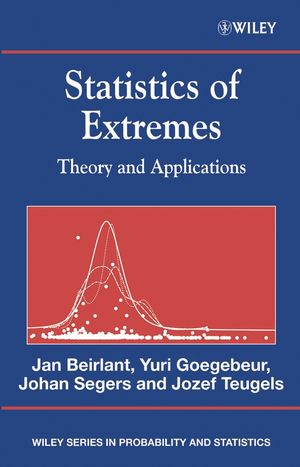Statistics of Extremes: Theory and ApplicationsISBN: 978-0-471-97647-9
Hardcover
512 pages
October 2004
 This is a Print-on-Demand title. It will be printed specifically to fill your order. Please allow an additional 10-15 days delivery time. The book is not returnable.
|
||||||
Preface.
1 WHY EXTREME VALUE THEORY?
1.1 A Simple Extreme Value Problem.
1.2 Graphical Tools for Data Analysis.
1.3 Domains of Applications.
1.4 Conclusion.
2 THE PROBABILISTIC SIDE OF EXTREME VALUE THEORY.
2.1 The Possible Limits.
2.2 An Example.
2.3 The Fr'echet-Pareto Case: ³ > 0.
2.4 The (Extremal) Weibull Case: ³ 0.
2.5 The Gumbel Case: ³ = 0.
2.6 Alternative Conditions for (C³ ).
2.7 Further on the Historical Approach.
2.8 Summary.
2.9 Background Information.
3 AWAY FROM THE MAXIMUM.
3.1 Introduction.
3.2 Order Statistics Close to the Maximum.
3.3 Second-order Theory.
3.4 Mathematical Derivations.
4 TAIL ESTIMATION UNDER PARETO-TYPE MODELS.
4.1 A Naive Approach.
4.2 The Hill Estimator.
4.3 Other Regression Estimators.
4.4 A Representation for Log-spacings and Asymptotic Results.
4.5 Reducing the Bias.
4.6 Extreme Quantiles and Small Exceedance Probabilities.
4.7 Adaptive Selection of the Tail Sample Fraction.
5 TAIL ESTIMATION FOR ALL DOMAINS OF ATTRACTION.
5.1 The Method of Block Maxima.
5.2 Quantile View--Methods Based on (C³).
5.3 Tail Probability View--Peaks-Over-Threshold Method.
5.4 Estimators Based on an Exponential Regression Model.
5.5 Extreme Tail Probability, Large Quantile and Endpoint Estimation Using Threshold Methods.
5.6 Asymptotic Results Under (C³ )-(C*³ ).
5.7 Reducing the Bias.
5.8 Adaptive Selection of the Tail Sample Fraction.
5.9 Appendices.
6 CASE STUDIES.
6.1 The Condroz Data.
6.2 The Secura Belgian Re Data.
6.3 Earthquake Data.
7 REGRESSION ANALYSIS.
7.1 Introduction.
7.2 The Method of Block Maxima.
7.3 The Quantile View--Methods Based on Exponential Regression Models.
7.4 The Tail Probability View--Peaks Over Threshold (POT) Method.
7.5 Non-parametric Estimation.
7.6 Case Study.
8 MULTIVARIATE EXTREME VALUE THEORY.
8.1 Introduction.
8.2 Multivariate Extreme Value Distributions.
8.3 The Domain of Attraction.
8.4 Additional Topics.
8.5 Summary.
8.6 Appendix.
9 STATISTICS OF MULTIVARIATE EXTREMES.
9.1 Introduction.
9.2 Parametric Models.
9.3 Component-wise Maxima.
9.4 Excesses over a Threshold.
9.5 Asymptotic Independence.
9.6 Additional Topics.
9.7 Summary.
10 EXTREMES OF STATIONARY TIME SERIES.
10.1 Introduction.
10.2 The Sample Maximum.
10.3 Point-Process Models.
10.4 Markov-Chain Models.
10.5 Multivariate Stationary Processes.
10.6 Additional Topics.
11 BAYESIAN METHODOLOGY IN EXTREME VALUE STATISTICS.
11.1 Introduction.
11.2 The Bayes Approach.
11.3 Prior Elicitation.
11.4 Bayesian Computation.
11.5 Univariate Inference.
11.6 An Environmental Application.
Bibliography.
Author Index.
Subject Index.
1 WHY EXTREME VALUE THEORY?
1.1 A Simple Extreme Value Problem.
1.2 Graphical Tools for Data Analysis.
1.3 Domains of Applications.
1.4 Conclusion.
2 THE PROBABILISTIC SIDE OF EXTREME VALUE THEORY.
2.1 The Possible Limits.
2.2 An Example.
2.3 The Fr'echet-Pareto Case: ³ > 0.
2.4 The (Extremal) Weibull Case: ³ 0.
2.5 The Gumbel Case: ³ = 0.
2.6 Alternative Conditions for (C³ ).
2.7 Further on the Historical Approach.
2.8 Summary.
2.9 Background Information.
3 AWAY FROM THE MAXIMUM.
3.1 Introduction.
3.2 Order Statistics Close to the Maximum.
3.3 Second-order Theory.
3.4 Mathematical Derivations.
4 TAIL ESTIMATION UNDER PARETO-TYPE MODELS.
4.1 A Naive Approach.
4.2 The Hill Estimator.
4.3 Other Regression Estimators.
4.4 A Representation for Log-spacings and Asymptotic Results.
4.5 Reducing the Bias.
4.6 Extreme Quantiles and Small Exceedance Probabilities.
4.7 Adaptive Selection of the Tail Sample Fraction.
5 TAIL ESTIMATION FOR ALL DOMAINS OF ATTRACTION.
5.1 The Method of Block Maxima.
5.2 Quantile View--Methods Based on (C³).
5.3 Tail Probability View--Peaks-Over-Threshold Method.
5.4 Estimators Based on an Exponential Regression Model.
5.5 Extreme Tail Probability, Large Quantile and Endpoint Estimation Using Threshold Methods.
5.6 Asymptotic Results Under (C³ )-(C*³ ).
5.7 Reducing the Bias.
5.8 Adaptive Selection of the Tail Sample Fraction.
5.9 Appendices.
6 CASE STUDIES.
6.1 The Condroz Data.
6.2 The Secura Belgian Re Data.
6.3 Earthquake Data.
7 REGRESSION ANALYSIS.
7.1 Introduction.
7.2 The Method of Block Maxima.
7.3 The Quantile View--Methods Based on Exponential Regression Models.
7.4 The Tail Probability View--Peaks Over Threshold (POT) Method.
7.5 Non-parametric Estimation.
7.6 Case Study.
8 MULTIVARIATE EXTREME VALUE THEORY.
8.1 Introduction.
8.2 Multivariate Extreme Value Distributions.
8.3 The Domain of Attraction.
8.4 Additional Topics.
8.5 Summary.
8.6 Appendix.
9 STATISTICS OF MULTIVARIATE EXTREMES.
9.1 Introduction.
9.2 Parametric Models.
9.3 Component-wise Maxima.
9.4 Excesses over a Threshold.
9.5 Asymptotic Independence.
9.6 Additional Topics.
9.7 Summary.
10 EXTREMES OF STATIONARY TIME SERIES.
10.1 Introduction.
10.2 The Sample Maximum.
10.3 Point-Process Models.
10.4 Markov-Chain Models.
10.5 Multivariate Stationary Processes.
10.6 Additional Topics.
11 BAYESIAN METHODOLOGY IN EXTREME VALUE STATISTICS.
11.1 Introduction.
11.2 The Bayes Approach.
11.3 Prior Elicitation.
11.4 Bayesian Computation.
11.5 Univariate Inference.
11.6 An Environmental Application.
Bibliography.
Author Index.
Subject Index.



